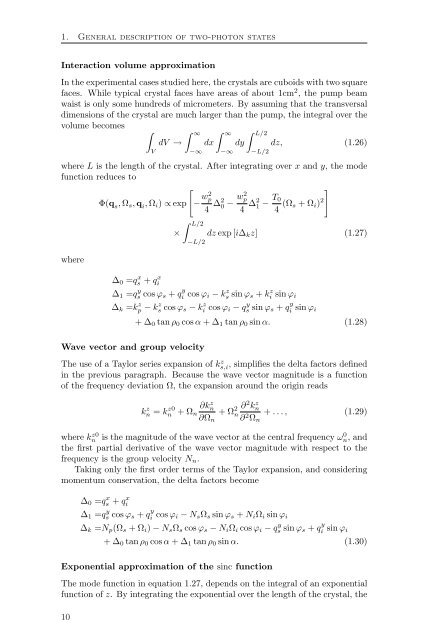Spatial Characterization Of Two-Photon States - GAP-Optique
Spatial Characterization Of Two-Photon States - GAP-Optique
Spatial Characterization Of Two-Photon States - GAP-Optique
Create successful ePaper yourself
Turn your PDF publications into a flip-book with our unique Google optimized e-Paper software.
1. General description of two-photon states<br />
Interaction volume approximation<br />
In the experimental cases studied here, the crystals are cuboids with two square<br />
faces. While typical crystal faces have areas of about 1cm 2 , the pump beam<br />
waist is only some hundreds of micrometers. By assuming that the transversal<br />
dimensions of the crystal are much larger than the pump, the integral over the<br />
volume becomes<br />
<br />
V<br />
dV →<br />
∞<br />
−∞<br />
∞ L/2<br />
dx dy dz, (1.26)<br />
−∞ −L/2<br />
where L is the length of the crystal. After integrating over x and y, the mode<br />
function reduces to<br />
<br />
<br />
where<br />
Φ(qs, Ωs, qi, Ωi) ∝ exp − w2 p<br />
4 ∆20 − w2 p<br />
4 ∆21 − T0<br />
4 (Ωs + Ωi) 2<br />
L/2<br />
× dz exp [i∆kz] (1.27)<br />
−L/2<br />
∆0 =q x s + q x i<br />
∆1 =q y s cos ϕs + q y<br />
i cos ϕi − k z s sin ϕs + k z i sin ϕi<br />
∆k =k z p − k z s cos ϕs − k z i cos ϕi − q y s sin ϕs + q y<br />
i sin ϕi<br />
+ ∆0 tan ρ0 cos α + ∆1 tan ρ0 sin α. (1.28)<br />
Wave vector and group velocity<br />
The use of a Taylor series expansion of kz s,i , simplifies the delta factors defined<br />
in the previous paragraph. Because the wave vector magnitude is a function<br />
of the frequency deviation Ω, the expansion around the origin reads<br />
k z n = k z0 ∂k<br />
n + Ωn<br />
z n<br />
+ Ω 2 ∂<br />
n<br />
2kz n<br />
∂2Ωn ∂Ωn<br />
+ . . . , (1.29)<br />
where k z0<br />
n is the magnitude of the wave vector at the central frequency ω 0 n, and<br />
the first partial derivative of the wave vector magnitude with respect to the<br />
frequency is the group velocity Nn.<br />
Taking only the first order terms of the Taylor expansion, and considering<br />
momentum conservation, the delta factors become<br />
∆0 =q x s + q x i<br />
∆1 =q y s cos ϕs + q y<br />
i cos ϕi − NsΩs sin ϕs + NiΩi sin ϕi<br />
∆k =Np(Ωs + Ωi) − NsΩs cos ϕs − NiΩi cos ϕi − q y s sin ϕs + q y<br />
i sin ϕi<br />
+ ∆0 tan ρ0 cos α + ∆1 tan ρ0 sin α. (1.30)<br />
Exponential approximation of the sinc function<br />
The mode function in equation 1.27, depends on the integral of an exponential<br />
function of z. By integrating the exponential over the length of the crystal, the<br />
10



